What is Hypertropin
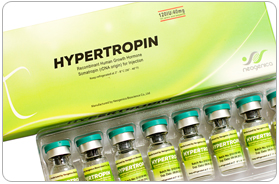 Hypertropin presents an exact amino acid sequence replica to
naturally occurring human growth hormone (HGH). NeoGenica BioScience Ltdmes in 12 IU vials of lyopholized (freeze-dried) powder which is to be reconstituted with plain sterile water for injection. Each Hypertropin vial is mixed with 1ml of sterile water and is then ready to be injected either intramuscular (into the muscle) or subcutaneous (under the skin). The dosage depends on the purpose. Some guidelines are these: 2IU per day for anti ageing purpose, 4IU per day for body building, shaping and weight loss, 8-16 IU per day for treatment of severe burns and injuries, etc. Please consult your doctor to determine a proper dosage for you.
Hypertropin presents an exact amino acid sequence replica to
naturally occurring human growth hormone (HGH). NeoGenica BioScience Ltdmes in 12 IU vials of lyopholized (freeze-dried) powder which is to be reconstituted with plain sterile water for injection. Each Hypertropin vial is mixed with 1ml of sterile water and is then ready to be injected either intramuscular (into the muscle) or subcutaneous (under the skin). The dosage depends on the purpose. Some guidelines are these: 2IU per day for anti ageing purpose, 4IU per day for body building, shaping and weight loss, 8-16 IU per day for treatment of severe burns and injuries, etc. Please consult your doctor to determine a proper dosage for you.
Hypertropin is designed to make the GH therapy process as easy as possible. Hypertropin offers these advantages to GH deficient patients:
Hypertropin is appropriate for
Child onset or pediatric GH deficiency. Hypertropin will help to alleviate the growth deficits associated with child onset GH deficiency.
Renal transplant management. The period leading up to a kidney transplant can be a period of insufficient growth due to renal insufficiency. Hypertropin can offer effective treatment for this growth deficiency, along with other therapeutic medications for the management of the renal insufficiency.
Long duration treatment for Turner Syndrome, and the limited growth that the syndrome can cause.
Long term management and replacement of GH in adult patients diagnosed with adult onset GH deficiency. The Hypertropin acts as a replacement for the naturally occurring, but absent, GH.
How to avoid infection while using Hypertropin
Always wash your hands thoroughly with warm water and soap before handling the medication, or beginning your injection routine.
Keep alcohol wipes handy, for easy cleaning and sanitation of the rubber stopper on the tops of the vials. You should ensure that you never touch the top of the vial after cleaning with the alcohol wipe.
Make certain that you clean the rubber stopper with an alcohol wipe, should you inadvertently touch the rubber stopper.
Always use the disposable hypodermic needles only once, and then dispose of safely.
Never share used hypodermic needles.
How Hypertropin is supplied
Hypertropin is supplied in 12 IU vials, each containing 4 mg of lyopholized sterile powder Somatropin [human growth hormone]. There are 10 vials per kit making a total of 120 IU or 40mg of Somatropin.
How to measure and administer a dose of Hypertropin
Before starting your treatment you need to get plain sterile water for injection and insulin type syringes. You will need 10ml of plain sterile water for a full 120 IU kit of Hypertropin. You will need 10 insulin type syringes. For easy dose measurement It's best if the syringes have 100 marks on them, but if those are unavailable, any will do - in that case you will just need to do some math. Insulin syringes and water should be very cheap so you might want to get a few extra just in case. It's always good to use a fresh syringe for mixing and another fresh syringe for injecting.
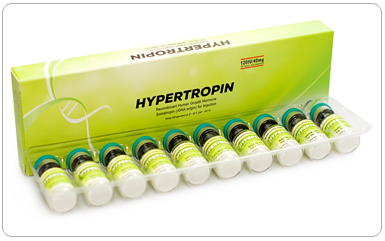 Step 1
Step 1
Pull the blue plastic top of Hypertropin vial off and clean the rubber top with an alcohol wipe. Rub thoroughly and vigorously over the entire surface area.
Step 2
Take off the plastic needle guard from the insulin syringe, and reserve for later. Draw back the plunger, and intake full syringe of air.
Step 3
Take the syringe and push the needle down slowly through the very top and middle of the rubber stopper on hypertropin vial. When the needle is through the rubber stopper, push down on the plunger, and empty completely the air from within the needle into the vial. This will ease the vacum which is in the vial.
Step 4
Clean the rubber top of the sterile water vial (which you bough yourself) with alcohol wipe, in the same way as you cleaned the Hypertropin top before. Push the needle of the insulin syringe trough that rubber and pull 1ml of water into the syringe. The 1ml measurement should be marked on the side of the syringe (the syringe can have 100 or 40 marks, marked on the side - that does not matter because a full syringe is normally 1ml no matter how many marks it has).
Step 5
Take the insulin syringe which is now full with 1ml of sterile water, push the needle trough rubber stopper on top of the Hypertropin vial. Do not inject the water directly into the powder with force! This may damage the HGH cells. Once the needle is inside, direct it to the side, pointing towards the glass and very slowly empty the entire 1ml of water into the Hypertropin vial - let the water slide down the glass and touch the powder. When all the water is in, take the insulin syringe out. The HGH will start dissolving slowly. Do not shake it! Take the Hypertropin vial in your hand and gently turn in between your fingers. It may take up to a few minutes for the powder to completely dissolve.
Step 6
You now have a dissolved 12 IU of human growth hormone ready for injection. Take a fresh insulin syringe. You may either pull the entire content of Hypertropin into the insulin syringe and use it multiple times (never touching the needle with your fingers) or you may use a fresh insulin syringe for each injection. In that case you have to do your math and calculate how much you need to pull out each time. Make sure that you thoroughly clean the skin on the injection spot with alcohol before each injection.
Step 7
Very gently pull the liquid HGH into the insulin syringe (violent pull may damage the HGH cells). Take the needle out of Hypertropin vial. You are ready for injection.
Choose an appropriate site for the injection
You should not repeat an injection often on the same body spot. Rather you should always rotate between many different injection sites. The HGH injection can either be given into the muscle or into subcutaneous layer (under the skin). The fatty space directly below the skin is the ideal target for the shallow Hypertropin injection.
There are a number of appropriate areas throughout the body for an injection. An appropriate area for an injection is anywhere that you can grasp the correct amount of skin as needed for correct administration of the injection.
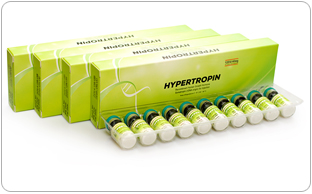 Abdomen
Abdomen
The abdomen is an effective site for an injection, as the fatty tissue underneath the skin of the abdomen easily absorbs the medication. Additionally, injections in this area can be less painful. Do not give injection too close to the navel (belly button), and also avoid giving the injection too low, as you might experience a painful irritation of the injection zone as it rubs with a waistband or belt.
Thighs
The thigh is another appropriate site for an injection. You can give the injection into either the front (top) or side of the thighs, but should not go into the thigh muscle. The injection should be given midway between the hip and the knee.
The buttocks
The buttocks are another good spot for an injection, and this is one of the least painful spots to receive the injection. You will need a partner to inject in this area. Lay down stomach down, and point your toes out as the injector grasps the skin of the buttock for the injection.
The upper arms
The fleshy part of the upper arm, near the tricep muscle, can also serve as a good spot for an injection.
Always remember to vary the site of the injection widely between the many different possible injections sites on the body.
There can occasional y develop a problem at the site of a repeat injection. Contact your health services provider if you observe any of the following symptoms
A protruding and persistent lump that does not dissipate in time.
A bruise that seems usually persistent, and doesn’t fade in time.
Infection at the site of the injection. Signs of infection are pus, redness, hotness to the touch and a persistent pain or redness.
How to give the injection
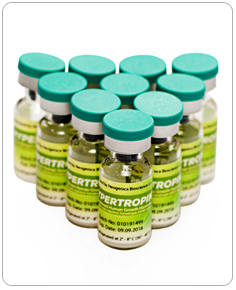 You will receive training from your health services provider on how to give an injection skillfully and effectively. You will with time develop the skill and confidence to deliver these injections with ease. With increased practice comes the risk of injury through inattention. You should always focus all of your attention on the correct injection procedure. The instructions that follow are a guide for giving an injection, but you should receive training in the correct method from your health care provider, and you should contact them if you are unsure about any of the injection procedures.
You will receive training from your health services provider on how to give an injection skillfully and effectively. You will with time develop the skill and confidence to deliver these injections with ease. With increased practice comes the risk of injury through inattention. You should always focus all of your attention on the correct injection procedure. The instructions that follow are a guide for giving an injection, but you should receive training in the correct method from your health care provider, and you should contact them if you are unsure about any of the injection procedures.
Step 1
Remove the clothing from around the area of the injection. You should never try to give an injection through any clothing, and you will need to expose the skin around the site of the injection for a proper cleaning. Take an alcohol pad or alcohol wipe, and thoroughly clean the area around the injection site. To do this, press firmly with the alcohol pad, and wipe around the site of the injection. Make sure that the alcohol has dried completely before beginning the injection.
Step 2
Always recheck your syringe to ensure that the correct dosage is ready for administration. Remove the needle guard from the needle tip carefully. Hold the syringe in a manner similar to the way that you would hold a pencil
Step 3
Grasp the skin around the injection site between your thumb and forefinger. Hold the skin securely both before and throughout the injection. The needle should be inserted with a confident and firm motion into the skin at a 45 degree angle.
Step 4
You should inject the medication slowly and gently. The complete injection of the liquid should take at least a few seconds to complete. When finished the injection, count 5 seconds before taking the needle out of the skin.
Step 5
You should cover the injection site with a sterile cotton ball after removing the needle. The area can be massaged if painful. A small quantity of blood may appear, and the injection site can be covered with a band aid if desired, although this is not strictly necessary.
Step 6
You should not attempt to recap the used needle. Your health care services official should have instructed you on the correct method for the disposal of both the used syringe and cap. The steps involved in the safe disposal of the used syringe are covered in the text below.
If you experience any difficulties, bad reactions, or have any questions about the injection procedures, you should always contact your health care provider as your primary source of information.
You should also have an open discussion about the possible repercussions and potential side effects of Hypertropin treatment.
How to dispose of used syringes
You should always dispose of used needles and needle guards immediately after giving an injection. Different states have different regulations and guidelines for the correct procedures to be used and acceptable containers for used syringes. Your healthcare provider will inform you of the obligations you have to dispose of the used needles safely, and in an approved manner.
For optimuim safety:
Never attempt to recap the used needle.
Immediately after giving the injection, dispose of the used needle and guard in the appropriate manner.
Never store your disposal container anywhere within the reach of children.
How to best store Hypertropin
Hypertropin can be stored at room temperature for at least 30 days. Extreme tests have been done in which Hypertropin remained potent at 37 degres celsius (98 degrees Fahrenheit) for 30 days and 45 degrees celsius (113 degrees Fahrenheit) for 7 days. You should however always store Hypertropin in refriegerator between 2 - 8 degrees Celsius (35 - 46 Fahrenheit). Do not freeze it! Hypertropin is light-sensitive and should be protected from light. Store the vials refrigerated in a dark place when they are not in use.
When mixed with water Hypertropin is good for 20 days if properly refrigerated between 2 - 8 degrees Celsius (35 - 46 Fahrenheit).
Additional safety information for all patients
GH therapy is not appropriate for cancer patients. If you have cancer or other tumors do not take HGH.
GH is not appropriate as a treatment option for people with acute and critical illnesses that have occurred through complications as a result of open heart surgery, accident trauma or on patients experiencing respiratory distress or failure.
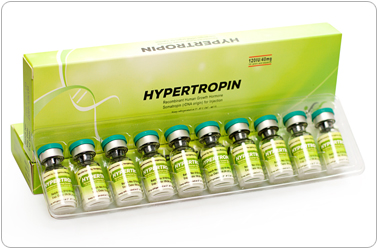 GH is not appropriate, and is contraindicated, for people with Prader-Willi syndrome who are extremely obese and or who are having respiratory difficulties. Generally, growth failure in pediatric patients with Prader-Willi syndrome should not be treated with Hypertropin, unless these pediatric patients have also demonstrated a GH deficiency. Long term treatment of Prader-Willi patients should not be initiated with Hypertropin
GH is not appropriate, and is contraindicated, for people with Prader-Willi syndrome who are extremely obese and or who are having respiratory difficulties. Generally, growth failure in pediatric patients with Prader-Willi syndrome should not be treated with Hypertropin, unless these pediatric patients have also demonstrated a GH deficiency. Long term treatment of Prader-Willi patients should not be initiated with Hypertropin
If a patient has a history of inter cranial lesions, they should be regularly examined by the health care team for any evidence of re emergent lesions.
If the GH patient experiences re occurring vomiting, nausea, vision changes and headache, they may be suffering from intracranial hypertension, and should by examined by their doctor.
Diabetes can complicate treatment with GH. GH treatment may influence your body’s response to insulin.
A very small percentage of people treated with GH, may develop antibodies to the protein.
Your health care provider should be made aware immediately of any indication of an allergic reaction (hives, rash or itching).
Your treatment should be closely monitored by your team of health care workers, as the treatment may need to be modified should you present evidence of side effects or excessive IGF-I levels. Excessive levels of IGF-I levels may carry additional health risks.
Information for use on children
Hypertropin is not appropriate for growth promotion on children that have demonstrated that their bone growth has finished naturally.
GH treatment can promote rapid growth. Rapid growth can cause an increased prevalence of separations of the joints. For this reason, parents and doctors should pay close attention to the mobility of children undergoing Hypertropin treatment, and any evidence of a limp or mobility complaint should be evaluated by a doctor immediately.
If the pediatric patient co presents Turners Syndrome, then the patient should be regularly checked for an inner ear infection; as these patients are at a greater risk for hearing injuries and disorders.
Turner syndrome patients need also be monitored closely for cardiovascular risk factors, as these patients are at an increased risk for hyper tension or stroke.
If undergoing treatment for growth failure due to renal insufficiency, patients should be monitored for the bone disease called renal osteodystropphy.
Although GH has never been shown to increase the prevalence of Scoliosis; Scoliosis is associated with rapid growth, and for that reason; GH patients should be monitored for the presentation of scoliosis.
For adults taking Hypertropin
There is no long term information for the health effects of long term treatment with Hypertropin on adult patients.
Pregnant women or nursing mothers should consult with their doctor about the possibility of continuing Hypertropin treatment.
The most frequently reported side effect from GH therapy is joint swelling and joint pain. This side effect occurs as a result an incorrect dosage regimen, and adjustments of the dosage regimen usually eliminate these problems.
For more compete information, please the information provided with the prescription medication.







